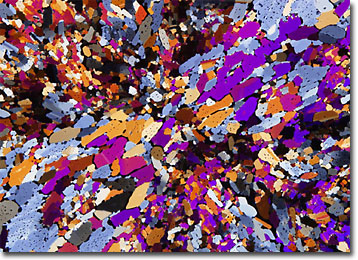Polarized Light Microscopy Digital Image Gallery
Nicotinic Acid
Also known as niacin and vitamin B3, nicotinic acid was first synthesized in 1867. It was not until 1937, however, that the importance of having adequate amounts of the substance in oneís diet was fully realized.

Nicotinic acid is a water-soluble vitamin found in a variety of foods, but is most concentrated in legumes, lean meats, eggs, and enriched breads and cereals. More stable than most other vitamins, little nicotinic acid is lost through cooking or exposure to water. The United States Food and Drug Administrationís Recommended Dietary Allowance (RDA) of the vitamin is approximately 20 milligrams per day for adults. Most studies show that the majority of Americans meet or exceed this requirement, which can also be supplemented by intake of the amino acid tryptophan, a precursor of nicotinic acid.
Involved in various functions within the body, nicotinic acid aids in red blood cell formation, plays an active role in more than 50 different enzymatic reactions, and is considered necessary to maintain the health of the skin and digestive tract. Consequently, a dietary deficiency of the vitamin is primarily characterized by digestive disturbances and skin lesions. Known as pellagra, this condition may also lead to dementia in severe or prolonged cases. Occurrences of pellagra are most common is countries whose inhabitants eat little or no protein-rich foods, but the illness is also sometimes a side effect experienced by long-term alcoholics. A similar condition that occurs in dogs is known as black tongue disease.
